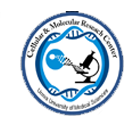|
|
1 |
| Plant-derived extracellular vesicles: a novel nanomedicine approach with advantages and challenges |
2 |
| Recent advances in mRNA-LNP therapeutics: immunological and pharmacological aspects |
3 |
| Recent highlights in the immunomodulatory aspects of Treg cell-derived extracellular vesicles: special emphasis on autoimmune diseases and transplantation |
4 |
| Aptamer-based biosensors for Pseudomonas aeruginosa detection |
5 |
| Development of gold nanoparticle-based biosensors for COVID-19 diagnosis |
6 |
| Spectrofluorimetric Method for Monitoring Methotrexate in Patients' Plasma Samples and Cell Lysates Using Highly Fluorescent Carbon Dots |
7 |
| Designing a humanized immunotoxin based on DELTA-stichotoxin-Hmg2a toxin: an in silico study |
8 |
| Tumor-promoting myeloid cells in the pathogenesis of human oncoviruses: potential targets for immunotherapy |
9 |
| Saffron: A functional food with potential molecular effects |
10 |
| Alpha7 nicotinic acetylcholine receptor expression in Sorafenib-resistant Hepatocellular carcinoma cells |
11 |
| Epidemiology and Antifungal Susceptibility of Candida Species Isolated from 10 Tertiary Care Hospitals in Iran |
12 |
| Memantine enhances the cisplatin-induced apoptosis in A2780 ovarian cancer cells via CyclinD1 and hTERT inhibition |
13 |
| Time to Conquer Fungal Infectious Diseases: Employing Nanoparticles as Powerful and Versatile Antifungal Nanosystems against a Wide Variety of Fungal Species |
14 |
| Recent advances and challenges in graphene-based nanocomposite scaffolds for tissue engineering application |
15 |
| The Promising Effect of Topiramate on Random-Pattern Skin Flap Survival in Rats |
16 |
| Morphology transition of Ag nanoprisms as a platform to design a dual sensor for NADH sensitive assay |
17 |
| Advances in Metal-organic Frameworks (MOFs) based Biosensors for Diagnosis: An Update |
18 |
| Effects of metformin on changes of miR-19a and miR-221 expression associated with myocardial infarction in patients with type 2 diabetes |
19 |
| Biomarker based biosensors: An opportunity for diagnosis of COVID-19 |
20 |
| Designing a Humanized Immunotoxin Based on HER2 Specific scFv and DFF40 Toxin Against Breast Cancer: An In-Silico Study |
21 |
| Carbon quantum dots may interfere with colorectal cancer treatment through affecting on glutamine metabolism |
22 |
| Chitosan-based biomaterials for the treatment of bone disorders |
23 |
| Synthesis and characterization of novel hybrid nanomaterials based on beta-cyclodextrine grafted halloysite nanotubes for delivery of doxorubicin to MCF-7 cell line |
24 |
| The PI3K/AKT signaling pathway in cancer: Molecular mechanisms and possible therapeutic interventions |
25 |
| Combination Therapy of Stem Cell-derived Exosomes and Biomaterials in the Wound Healing |
26 |
| Bile acid-based advanced drug delivery systems, bilosomes and micelles as novel carriers for therapeutics |
27 |
| Dual Blockade of PD-1 and LAG3 Immune Checkpoints Increases Dendritic Cell Vaccine Mediated T Cell Responses in Breast Cancer Model |
28 |
| Stem Cell Technology and Skin Disorders: from Stem Cell Biology to Clinical Applications |
29 |
| Type-I interferons in the immunopathogenesis and treatment of Coronavirus disease 2019 |
30 |
| Self-propelled micro/nanobots: A new insight into precisely targeting cancerous cells through intelligent and deep cancer penetration |
31 |
| The emerging role of mast cells in skin cancers: involved cellular and molecular mechanisms |
32 |
| SARS-CoV-2 and Guillain-Barré Syndrome: Lessons from Viral Infections |
33 |
| Molecular signaling pathways, pathophysiological features in various organs, and treatment strategies in SARS-CoV2 infection |
34 |
| Single Nucleotide Polymorphisms (SNP) and SNP-SNP Interactions of the Surfactant Protein Genes Are Associated With Idiopathic Pulmonary Fibrosis in a Mexican Study Group; Comparison With Hypersensitivity Pneumonitis |
35 |
| Glucose oxidase: Applications, sources, and recombinant production |
36 |
| Current advances and challenges in COVID-19 vaccine development: from conventional vaccines to next-generation vaccine platforms |
37 |
| The importance of neopterin in COVID-19: The prognostic value and relation with the disease severity |
38 |
| Multicenter Study of Susceptibility of Aspergillus Species Isolated from Iranian University Hospitals to Seven Antifungal Agents |
39 |
| Ethanol Consumption Promotes TNF-alpha Signaling Pathway in Rat Kidney: Rescue Effect of Curcumin |
40 |
| Understanding human mast cells: lesson from therapies for allergic and non-allergic diseases |
41 |
| Gastroprotective effect of topiramate on indomethacin-induced peptic ulcer in rats: Biochemical and histological analyses |
42 |
| MicroRNAs as therapeutic targets in breast cancer metastasis |
43 |
| Hematological Consequences of Valproic Acid in Pediatric Patients: A Systematic Review with a Mechanistic Approach |
44 |
| Ficus carica hairy roots: In vitro anti-leishmanial activity against Leishmania major promastigotes and amastigotes |
45 |
| Gastrointestinal disorder biomarkers |
46 |
| Implantable magnetic nanofibers with ON-OFF switchable release of curcumin for possible local hyperthermic chemotherapy of melanoma |
47 |
| beta-Galactosidase: From its source and applications to its recombinant form |
48 |
| Mammalian target of rapamycin (mTOR) signaling pathway and traumatic brain injury: A novel insight into targeted therapy |
49 |
| A brief overview on the application and sources of alpha-amylase and expression hosts properties in order to production of recombinant alpha-amylase |
50 |
| Biocompatible functionalized graphene nanosheet for delivery of doxorubicin to breast cancer cells |
51 |
| Exosomal microRNAs and long noncoding RNAs: Novel mediators of drug resistance in lung cancer |
52 |
| Oral cancer: Nanoparticles as a new horizon in the diagnosis and phototherapy-based therapies |
53 |
| Protective effects of tropisetron on diabetes-induced cardiomyopathy and apoptosis in the left ventricle of rats |
54 |
| Designing a Multi-Epitope Antigen for Serodiagnosis of Strongyloides stercoralis Based on L3Nie.01 and IgG Immunoreactive Epitopes |
55 |
| Significance of Cardiac Troponins as an Identification Tool in COVID-19 Patients Using Biosensors: An Update |
56 |
| Significance of Mast Cell Formed Extracellular Traps in Microbial Defense |
57 |
| Plasmon-enhanced fluorimetric and colorimetric dual sensor based on fluorescein/Ag nanoprisms for sensitive determination of mancozeb |
58 |
| Potential benefits versus hazards of herbal therapy during pregnancy; a systematic review of available literature |
59 |
| Identification of a biological form in the Anopheles stephensi laboratory colony using the odorant-binding protein 1 intron I sequence |
60 |
| Decreased Expression of Cytotoxic T Lymphocyte-associated Protein 4: A Risk Factor of Myocardial Infarction |
61 |
| Microwave-assisted facile synthesis of N, P co-doped fluorescent carbon dot probe for the determination of nifedipine |
62 |
| Molecular pathways involved in COVID-19 and potential pathway-based therapeutic targets |
63 |
| A turn off-on fluorometric and paper-based colorimetric dual-mode sensor for isoniazid detection |
64 |
| Toxoplasma gondii activates NLRP12 inflammasome pathway in the BALB/c murine model |
65 |
| PI3K Inhibition Sensitize the Cisplatin-resistant Human Ovarian Cancer Cell OVCAR3 by Induction of Oxidative Stress |
66 |
| Functional Nanomaterials |
67 |
| Dietary compounds as inhibitors of DNA methyltransferases |
68 |
| Testing and diagnosis of SARS-CoV-2 infection |
69 |
| Characterization of nanoparticles: methods and techniques |
70 |
| Electrospun Polycaprolactone Nanofibers: Current Research and Applications in Biomedical Application |
71 |
| MicroRNAs and drug resistance in colorectal cancer with special focus on 5-fluorouracil |
72 |
| Molecular variants of SARS-CoV-2: antigenic properties and current vaccine efficacy |
73 |
| In Vitro Human Cancer Models for Biomedical Applications |
74 |
| Signaling Pathways Involved in 5-FU Drug Resistance in Cancer |
75 |
| An overview of possible pivotal mechanisms of Genistein as a potential phytochemical against SARS-CoV-2 infection: A hypothesis |
76 |
| Association of Matrix Metalloproteinase-2 (MMP-2) and MMP-9 Promoter Polymorphisms, Their Serum Levels, and Activities with Coronary Artery Calcification (CAC) in an Iranian Population |
77 |
| Melatonin Sensitizes OVCAR-3 Cells to Cisplatin through Suppression of PI3K/Akt Pathway |
78 |
| Downregulation of miR-125a-5p and miR-218-5p in Peripheral Blood Mononuclear Cells of Patients with Relapsing-Remitting Multiple Sclerosis |
79 |
| Acute and sub-acute toxicity assessment of the standardized extract of Sanguisorba minor in vivo |
80 |
| Cytomegalovirus UL97 ganciclovir resistance mutations in kidney transplant recipients |
81 |
| Etiopathogenesis of Psoriasis from Genetic Perspective: An updated Review |
82 |
| Sulfur quantum dots as a novel platform to design a sensitive chemiluminescence probe and its application for Pb2+ detection |
83 |
| Anti-toxoplasma and Cytotoxic Activities of Holothuria leucospilota Extract and TiO2 NPs In vitro and In vivo |
84 |
| The Effect of Curcumin on the Expression of INFgamma, TNF-alpha, and iNOS Genes in PBMCs Infected with Leishmania major [MRHO/IR/75/ER] |
85 |
| UPAR Overexpression Could Be a Potential Favorable Prognostic Marker in Invasive Ductal Carcinoma of Breast |
86 |
| Risk factors for mortality in hospitalized patients infected with carbapenem-resistant Pseudomonas aeruginosa in Iran |
87 |
| Evaluation of interleukin-17 receptor (IL-17RA) gene expression in PBMCs of patients with premature coronary artery disease |
88 |



